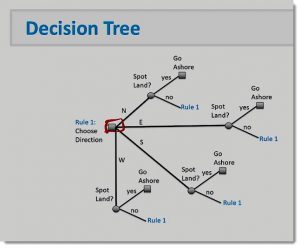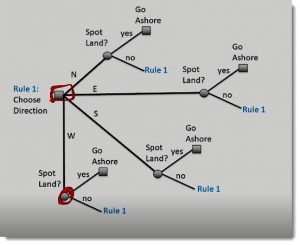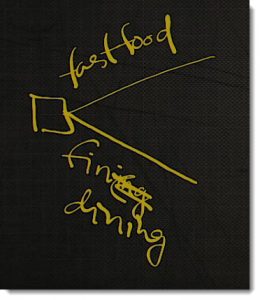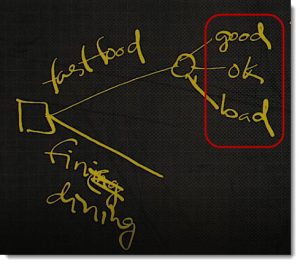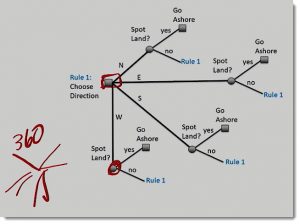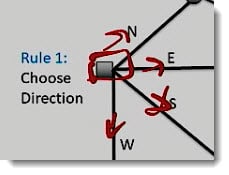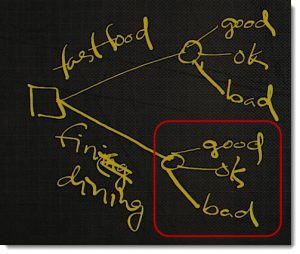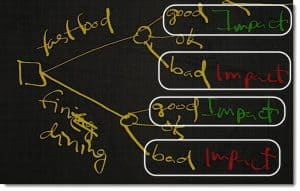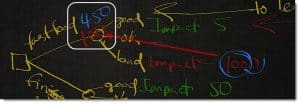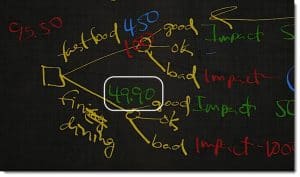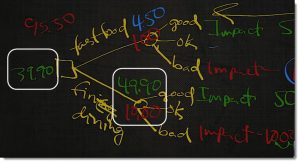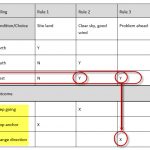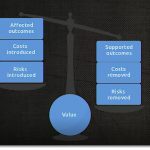Decision Trees in Business Analysis PMI-PBA (Fast Food vs Fine Dining?)
Decision Trees in Business Analysis PMI-PBA (Fast Food vs Fine Dining?)
This post if from our PMI-PBA Business Analysis Certification course. Start training today!
This is a simplified nautical explanation of Decision Trees to help represent some of the features that PMI and/or IIBA reference when they’re taking about decision trees. We’ll go a little further into this.
The concept is that you’re going to make some decisions and based on the decisions, you’re going to have outcomes.
A decision or a choice you might make is drawn by a square or a box and the outcome or the alternatives that arise as a result of that decision are typically shown as a zero, or circle, or a sphere depending on how they draw it.
This is just an example of making decisions. What you’re doing in this particular rule model is you’re identifying when do you make choices and when based on the choices do you have outcomes.
If you were to go and take a course in statistics. I took two of them during my MBA program, and one of those was an entire semester learning how to build and solve decision trees.
They can be used for a lot of other mechanisms other than just business analysis rule planning. Be aware that the entire field or use of decision trees is much greater specifically than business analysis.
I have an hour long webinar where I walk through how to build and use decision trees. Check it out. Principles of Decision Tree Design and Analysis in Project Management (PMP)
Principles of Decision Tree Design and Analysis in Project Management (PMP)
For the PMI‑PBA exam, there are a couple of elements you need to understand though. I’m going to give overview of decision trees.
You always build a decision tree, so you always build them from left to right.
Once you have an entire decision tree built or you believe you built it the way that you solve it, or in the business analysis sense, the way you review it to make sure that it’s accurate is you solve from right to left.
Once I get into this general overview for how you do it, you’re going to start with your choices.
For example, let’s say you’re getting hungry. You’re either going to go to fast food or you’re going to go to fine dining.
Once you make that decision, there are some outcomes that you may or may not be able to control. When I talk about outcomes, the food is good, the food is just OK or the food is bad.
Now, here’s where I maybe disagree from what Business Analysts do. Because you want to make it easy, concise for people to follow rules, at least on the PMI‑PBA exam and to some degree on the Business Analyst Body of Knowledge (BABOK) and the exam for the Certified Business Analysis Professional (CBAP). They suggest that you should always build a diagram that has only two outcomes / two choices at a time. That gets really difficult to do.
The reason I state that is if we’re talking about what compass direction do we go on?
If you know a compass, a compass has 360 degrees and maybe half degrees and feet and seconds. You don’t have one option, you have lots of them.
Trying to get this down to just two simple choices, go left, go right, maybe that works in a maze that’s got very square corners not so much in larger world type scale of issues. Trying to do that just with two is difficult because we have at least four major directions ‑‑ north, east, south and west.
Be aware that typically on the test, they’re going to say any time you want to simply or make it concise, you want to try to get it down to two choices by your process. This is why we’re going from, create from left to right, solve from right to left.
If we go fine dining, we have the same outcome. It’s good, it’s OK or it’s bad.
Remember, as a Business Analyst our goal is always to look at things like impact. If it’s good, we have a positive impact, and that will be in both cases. If it’s bad, we have a negative impact.
To do this from a risk perspective trying to solve this, I might say that, fast food if it’s good it’s only worth five dollars to me.
Fast food if it’s bad might imply food poisoning. Food poisoning might cause me to lose $1,000 in terms of lost wages and medical bills to get through that food poisoning. That’s a negative, that’s why I did it in the red.
My impact for fine dining might be to me that I love a great meal that’s worth $50 to me. If I get sick on that fine dining it’s also a loss of $1,000.
I can start solving this, just the impact. If you’re a Project Manager you need to solve it by incorporating probability as well. I’m just not going to do that here to shorten it to give you the concept.
If I were solving this from, again right to left. I need to know the probability of it. If most of the time I’m going to have a high impact 90 percent of the time and 10 percent of the time I’m going to have $1,000 loss.
If it’s 90 percent that I’m going to be good up here. Let’s see, 90 percent times five dollars is $4.50 so I’m solving back to the left.
Back here I have a $4.50 gain here and the impact means that 10 percent of the time I’m going to be losing $1,000. If that’s 10 percent and I come over here, that’s $100 loss.
What I’ve got here is $4.50 effectively is going to be my gain but $100 is going to be my loss. When I put the two of these together, here’s my $100 loss solving from right to left.
I have $100 loss, plus I have a $4.50 gain out of this just by probability. That doesn’t look so good. That fast food, by just rules from my decision suggest that I’m going to have ‑‑ if I calculate this quickly in my head ‑‑ a $95.50 overall loss.
This is just trying to do some impact analysis. This is a decision tree, the rules we’re following.
Let’s do the same thing for fine dining.
Let’s just say that when we go to fine dining, particularly a great restaurant, my impact over here for this is going to be 99 percent of the time, we’re going to have this great outcome.
99 percent of the time, I’m just going to round it. That means we’re approx $49.90. That’s my gain.
49.90 is my gain on this 99 percent of the time and one percent of the time, I’m going to have a loss. One percent I’m moving the decimal point over a couple of places, so I’m going to have a $10 loss.
That $10 loss is a negative here over a 10. My aggregate solution for fine dining is a $39.90 gain by, again, adding or aggregating from the right to the left.
My wife loves this solution that suggests that we should always do fine dining rather than our decision to try to do fast food.
This is a decision tree.
You won’t have to solve them on the PMI‑PBA exam, at least not the version through June, July of 2018. You need to understand the concept that the squares are your choices or decisions, the O’s are your outcomes or choices.
That you’re creating them from left to right and you’re always reading or solving them from right to left, and that decision trees are a form of a rule model.
I look forward to seeing you in the classroom or online!
Steven Fullmer
Interface Technical Training Staff Instructor
Steve teaches PMI-PBA: Business Analysis Certification, PMP: Project Management Fundamentals and Professional Certification, Windows 10, and CompTIA classes in Phoenix, Arizona.
Steve’s Video Certification Training Classes at Interface Technical Training:
Project Management Professional (PMP®) Certification Video Training PMBOK® 6th Edition
PMI-PBA Business Analysis for IT Analysts and Project Managers (PMI-PBA)® Certification
You May Also Like
A Simple Introduction to Cisco CML2
0 3898 0Mark Jacob, Cisco Instructor, presents an introduction to Cisco Modeling Labs 2.0 or CML2.0, an upgrade to Cisco’s VIRL Personal Edition. Mark demonstrates Terminal Emulator access to console, as well as console access from within the CML2.0 product. Hello, I’m Mark Jacob, a Cisco Instructor and Network Instructor at Interface Technical Training. I’ve been using … Continue reading A Simple Introduction to Cisco CML2
Cable Testers and How to Use them in Network Environments
0 727 1This content is from our CompTIA Network + Video Certification Training Course. Start training today! In this video, CompTIA Network + instructor Rick Trader demonstrates how to use cable testers in network environments. Let’s look at some tools that we can use to test our different cables in our environment. Cable Testers Properly Wired Connectivity … Continue reading Cable Testers and How to Use them in Network Environments
Data Models in Business Analysis
0 200 0This video is from our PMI-PBA Business Analysis for IT Analysts and Project Managers (PMI-PBA)® Certification now available at Interface Technical Training. Also see Steve’s PMP Project Management Certification Course: Project Management Professional (PMP®) Certification Video Training PMBOK® 6th Edition Video Transcription: Data Models are part of the elicitation analysis in PMI-PBA. This is the way … Continue reading Data Models in Business Analysis

